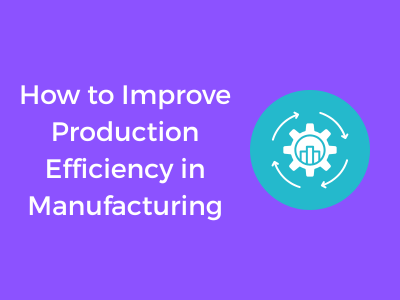Welcome to the fascinating world of manufacturing efficiency! When we talk about production efficiency, we’re essentially asking the question: “How can we achieve the best possible results with the minimum use of resources?” Seems straightforward, right? Well, let’s unfold this core concept and see what really makes efficiency tick.
At its heart, efficiency is about maximizing output while minimizing input. It’s not just doing more with less; it’s about doing the right things the right way. In manufacturing, this means producing high-quality products in the shortest time possible, using fewer resources like energy, materials, and labor, without compromising the end quality or overburdening your workforce. Think of it as creating a harmonious balance between effort and results.
Why is Efficiency Such a Big Deal?
Have you ever wondered why businesses chase efficiency so relentlessly? It’s not just about saving money (although that’s a major perk). Here’s why it matters:
- Cost Control: The more efficient your process, the fewer resources you use, and the lower your operating costs become.
- Competitiveness: A more efficient operation can deliver products faster, positioning your brand ahead of the competition.
- Customer Satisfaction: Efficient systems help meet deadlines, maintain quality, and keep customers happy (and coming back for more!).
- Environmental Impact: Less wasted material and energy equals a greener production process, which is great for the planet too!
The “Golden Pillars” of Efficiency
So, how do we measure what “efficiency” looks like in practice? Here are three golden pillars to get you started:
- Resource Optimization: Efficiency shines when every material, machine, and worker is utilized to its full potential without waste or idle time.
- Consistency: Efficient systems don’t just perform well on good days. They consistently deliver high productivity and quality over time.
- Adaptability: The modern manufacturing landscape changes quickly. True efficiency includes the ability to adjust processes without massive disruptions.
Identifying Critical Sources of Operational Waste
Alright, let’s talk about waste. No, not the kind you toss in the trash can, but the kind that can quietly seep into your manufacturing processes, costing time, money, and resources. Identifying and addressing operational waste is one of the first steps to creating a more efficient and competitive production environment—and yes, it’s entirely doable! Let’s dive in and uncover those critical culprits of waste one-by-one.
What Exactly Is ‘Operational Waste’?
Operational waste is any activity, resource, or process that doesn’t add value to your final product or service. And value, let’s be clear, is determined by your customer. If a task doesn’t improve the quality, function, or desirability of your product, it’s probably wasteful. That may sound simple on paper, but in a busy manufacturing setup, waste can creep in where you least expect it!
Key Types of Operational Waste
- Overproduction: Making more than you need, too soon, or too fast is often the biggest source of waste. Imagine producing extra units that sit idle waiting for orders. That’s tying up valuable resources with no guarantee of return.
- Excess Motion: If workers, equipment, or materials are constantly on the move (or in a wild goose chase to find what they need), that’s a red flag. Streamlined workflows and site layouts are your friends here!
- Defects: Rework and scrapped materials due to product defects eat directly into your profits. Plus, think about the time lost fixing errors that could have been avoided in the first place.
- Idle Time (Waiting): Machines sitting idle or employees waiting for materials to arrive—it all adds up. Every minute wasted is a minute you’re not creating value.
- Inventory Waste: Holding excessive raw materials or finished products clutters your operation and locks up cash reserves. “Having too much of a good thing” definitely applies here.
- Overprocessing: When you’re doing more work or adding features beyond what the customer expects or is willing to pay for, it’s like writing an epic novel when a short story will do. Get to the point efficiently!
- Unutilized Talent: This is a sneaky one—when you underuse or don’t properly leverage your team’s skills, that’s an intangible but serious type of waste. And, let’s face it, nobody wants to feel like their talents are going unnoticed.
How to Spot These Wastes?
Now that we know the types of waste, the next challenge is spotting them. Start by walking the floor (a practice often called a Gemba Walk in Lean Manufacturing). Observe your processes, talk with workers, and take notes on inefficiencies. Once you’ve identified problem areas, involve your team in brainstorming solutions. After all, your employees are in the trenches and often have ideas that leadership may not initially consider.
Pro Tips for Tackling Operational Waste
- Map Your Processes: Create a value stream map to visualize your workflow and pinpoint bottlenecks or redundant steps.
- Communicate Effectively: Ensure every employee understands the value of their role in eliminating waste. Training is key!
- Declutter: Use organization techniques like the 5S system (Sort, Set in Order, Shine, Standardize, Sustain) to reduce disorganization and chaos.
- Embrace Continuous Improvement: Once you’ve reduced waste, don’t just stop there. Regularly reassess your processes for new opportunities to improve.
Technology’s Role: Automation and Smart Systems

Let’s face it: technology has revolutionized the way manufacturing works today. It’s like having a secret superpower that keeps pushing the boundaries of what’s possible. From robots on the assembly line to systems that seem to “think” on their own, incorporating technology into manufacturing isn’t just a trend – it’s the industry standard for staying competitive. Grab a coffee, sit back, and let’s dive into how automation and smart systems can seriously boost production efficiency.
Why Automation is a Game-Changer
Imagine if your team could focus on the creative and strategic parts of their jobs while machines took care of repetitive, routine tasks. Sounds like a dream, right? That’s exactly what automation offers. By introducing automated robotics and machinery into your workflow, you can eliminate bottlenecks, reduce errors, and speed up production times.
For example:
- Robots can perform tasks like sorting, welding, or packaging far faster and more accurately than humans can.
- Automated conveyor belts can keep production lines running smoothly, reducing downtime significantly.
- Automated Quality Control (QC) systems equipped with cameras and AI can scan for defects in mere seconds!
The result? Your team isn’t bogged down by monotonous tasks, your customers get consistent quality, and your production process becomes a well-oiled machine – literally.
Smart Systems: The Brain Power Behind Efficiency
Now, automation is fantastic, but when you add smart technology to the mix, you unlock an entirely new level of optimization. Smart systems, often powered by the Internet of Things (IoT) and Artificial Intelligence (AI), bring intelligence to manufacturing operations.
Think of these technologies as your factory’s “virtual assistant.” They not only collect data but also interpret it and recommend actions based on real-time insights.
Here are a few ways they transform factories:
- Predictive Maintenance: Sensors can detect when machinery is starting to wear out or might fail. By alerting teams in advance, smart systems help avoid costly unplanned downtime.
- Energy Optimization: AI-powered systems can monitor energy consumption and suggest ways to reduce waste, cutting costs and being kinder to the environment.
- Inventory Management: IoT-enabled devices track inventory levels and ensure just-in-time production, so you’re never overstocked or understocked again.
What’s incredible is just how scalable these systems are. Whether you’re running a small workshop or a giant manufacturing plant, digital tools can be tailored to meet your specific goals.
Getting Started Doesn’t Have to Be Intimidating
If you’re not a tech enthusiast, transforming your factory with automation and smart systems might feel overwhelming. But don’t worry – you can start small! Consider beginning with a single automated workstation or adopting a basic IoT device for monitoring energy usage. As you start seeing results, you’ll quickly realize how these systems save time, money, and effort.
Think of it as planting a tiny seed for efficiency, which over time, grows into a thriving, productive system.
Lean Practices: Streamlining for Long-Term Success

Let’s talk about a game-changer in manufacturing that has proven its worth time and time again: Lean practices. If you’re aiming to boost productivity while cutting down on waste, embracing Lean thinking is not just smart—it’s essential! It’s like a roadmap to efficiency, helping you focus on what truly matters and trimming the things that don’t. Sound good? Let’s dive into the why’s and how’s.
What Exactly Are Lean Practices?
Lean practices revolve around one simple yet powerful idea: maximize value for the customer while minimizing waste. Born from Toyota’s revolutionary manufacturing philosophy, Lean is all about doing more with less, simplifying processes, and continuously improving to achieve long-term efficiency. It’s not just technical—it’s cultural as well, requiring every team member to embrace its values.
Cutting the Fluff: Targeting Wastes
Here’s a wild fact: Lean identifies seven types of waste that every manufacturer needs to battle. Things like overproduction, waiting (for materials or approvals), unnecessary transportation, excess inventory, motion without purpose, defects, and overprocessing can all wreak havoc on efficiency. So, the first step is to pinpoint these areas and start shaving them down. Trust us, every little bit adds up!
Key Lean Tools and Techniques
Now let’s talk about the “how.” Implementing Lean practices starts with understanding the tools available. Spoiler alert: they’re not as intimidating as they sound! Some of the most popular techniques include:
- 5S Methodology: This stands for Sort, Set in Order, Shine, Standardize, and Sustain. It’s essentially about organizing the workspace so that it’s neat, efficient, and easy to maintain.
- Just-in-Time (JIT): With this approach, materials and products are delivered exactly when needed, reducing inventory concerns and storage costs. No more stuff piling up!
- Kaizen: The philosophy of continuous improvement. Small, consistent changes made daily can create massive improvements over time. It’s like flexing your factory’s “get better” muscle!
- Value Stream Mapping: This is like taking an X-ray of your production process. You map out each step to identify where value is added—and where it’s not.
Why Lean Practices Are a Long-Term Asset
Here’s the best part—Lean doesn’t just improve your processes; it transforms your company culture. It fosters a mindset of seeking efficiency in every corner, empowering teams to innovate and problem-solve. A Lean-focused workplace becomes resilient, adaptable, and better at weathering market fluctuations. Over time, it even improves your bottom line by reducing costs and boosting customer satisfaction. Isn’t that what we all want?
Common Pitfalls to Avoid
Of course, nothing good comes without challenges. Many manufacturers struggle with sustaining Lean improvements over time. Why? Because it requires commitment! Don’t fall into the trap of treating Lean as a one-and-done project. It’s a journey (and yes, worth every step).
Another issue is neglecting the human factor. Your team members are at the heart of Lean. If they’re not on board or trained properly, even the best systems can falter. So, engage them early and encourage their input when rolling out Lean initiatives!
Workforce Engagement: Skills, Training, and Collaboration
Ah, the workforce—the heart and soul of any manufacturing operation. When we talk about improving production efficiency, we often dive straight into fancy tech and streamlined systems. While these are super important, one element often gets sidelined: the people. Let’s take some time to focus on how boosting workforce engagement can skyrocket production efficiency. Ready? Let’s dig in!
Why Your Workforce Is Your Secret Weapon
Machines can perform miracles, but they can’t think, innovate, or troubleshoot like a human brain paired with skilled hands. Your employees play a critical role in the manufacturing process, so it makes sense to invest in nurturing their skills and maintaining their enthusiasm. Think of it as giving them the tools to make magic happen on the production floor. Makes sense, right?
The Power of Skills and Training
Let’s be real: If your employees don’t feel confident in what they’re doing, efficiency is going to take a serious hit. That’s why training programs are non-negotiable. Here’s how you can tackle it:
- Ongoing Training: Regular training keeps your workforce up-to-date with ever-advancing technologies and processes.
- Tailored Learning Opportunities: Not everyone learns the same way. Consider a mix of hands-on practice, digital modules, and group workshops to address various learning styles.
- Lead By Example: Managers and senior staff should model skills and behaviors, inspiring others to follow suit.
Investing in training reduces errors, makes operations safer, and, let’s face it, makes your employees feel valued. Win-win!
Encourage Collaboration for Ultimate Teamwork
Manufacturing isn’t an island. It’s like a complex puzzle with each team fitting in to create a bigger, beautiful picture. Encouraging collaboration among teams fosters creativity and ensures that everyone is on the same page.
Here’s how you make collaboration seamless:
- Set shared goals so departments realize they’re all rowing the boat in the same direction.
- Use cross-department training to build understanding, trust, and cohesion.
- Use tools like communication apps or digital dashboards to keep everyone informed.
- Create regular feedback loops where employees across levels feel heard and empowered to speak up.
A shared sense of purpose can do wonders for morale and efficiency. Plus, it makes work just plain enjoyable!
Recognition and Growth Opportunities
Shout out to your workers every chance you get. Seriously, recognition goes a long way in fostering motivation. A “thank you” or acknowledging how someone saved the day boosts morale and keeps engagement high. Better yet, offer growth opportunities, like upskilling programs, leadership workshops, or chances to climb the career ladder. Isn’t it satisfying to know you’re contributing to not just the company’s success but your team’s personal and professional growth?
Measuring and Analyzing Key Efficiency Metrics
Alright, let’s talk numbers! When it comes to improving production efficiency in manufacturing, you can’t just make changes and hope for the best. Nope, you’ve got to measure your progress, analyze the data, and figure out what’s working and what’s not. Think of it as the feedback loop that turns guesswork into a well-oiled, well-informed machine. So how do you go about measuring and analyzing efficiency metrics? Let’s break it down!
1. Start with the Basics: Identify the Metrics That Matter
You don’t need to measure everything under the sun—focus on metrics that truly impact your bottom line and overall goals. Some key ones you might want to consider include:
- Overall Equipment Effectiveness (OEE): This is like the holy grail of efficiency metrics. It looks at three critical factors: availability (is the machine running?), performance (is it running at its full potential?), and quality (are the parts being produced meeting standards?). Basically, OEE is your go-to for understanding the big picture.
- Cycle Time: How long does it take to produce one unit, start to finish? Tracking this helps you identify bottlenecks and areas for improvement.
- Downtime: Unplanned downtime is efficiency’s worst enemy. Keep track of how often your machines are idle and why that’s happening.
- Yield: What percentage of your products meet quality standards right off the line? A higher first-pass yield means fewer resources wasted on rework.
Once you know what you’re looking for, you’re ready to dig deeper.
2. Gather Data Using Technology
If you’re still using pen and paper to track manufacturing data, you might want to consider upgrading. Today’s factories have access to all kinds of amazing tools:
- Machine Sensors: These can provide real-time data on everything from performance to temperature, helping you stay on top of any issues as they arise.
- Manufacturing Execution Systems (MES): Think of this as a central hub for collecting, analyzing, and reporting data from across the production floor.
Investing in the right tech not only makes data collection easier but also improves accuracy. And that’s a win-win!
3. Analyze Like a Pro: Look for Patterns
Data is only useful if you know how to interpret it. This is where analysis comes in. Look for trends and patterns over time—did productivity improve after a workflow change? Are there specific machines or processes that consistently underperform?
Make a habit of diving into granular data, but don’t lose sight of the big picture. For example, if downtime is a constant challenge, is it because of outdated equipment, lack of training, or something else entirely? Pinpointing the “why” behind the numbers is how you make meaningful decisions.
4. Continuous Improvement: Set Goals and Benchmark
Once you’ve got all this juicy data at your fingertips, use it to set actionable goals. For instance, if your OEE score is hovering around 60%, challenge your team to push it to 70% within six months. Be sure to break those goals into smaller, manageable tasks that align with your broader strategy.
Don’t forget to benchmark against industry standards or your competitors. It’s a great way to see how you stack up and identify areas where you could become a leader.
5. Make It a Team Effort
Efficiency isn’t an individual sport—it’s a team game. Share the insights you gather with your workforce, celebrate wins, and pull everyone into the goal-setting process. When your team knows what they’re working toward and why it matters, you’ll see both morale and productivity improve.
Sustainable Methods for Improving Output Quality
Improving output quality in manufacturing isn’t just about cranking out more products—it’s about ensuring those products are consistently top-notch, all while keeping one eye on sustainability. The good news? Adopting sustainable methods doesn’t have to be intimidating. Let’s break it down and explore some smart strategies that can elevate your production game.
1. Start with High-Quality Materials
You can’t make a great cake with stale ingredients, right? Similarly, in manufacturing, the quality of your raw materials has a massive impact on your final product. Partner with reliable suppliers who adhere to standards that align with your company’s quality and sustainability goals. Bonus points if those materials are eco-friendly or recycled—helping the planet and your bottom line! Look for certifications like FSC for wood products or GRS certification for recycled inputs, as these provide assurance of sustainability.
2. Optimize Your Production Processes
Certain methods of production simply get better results while being efficient and sustainable. For example:
- Utilizing energy-efficient machinery: Machines that consume less power save energy and often improve precision.
- Creating clear standard operating procedures (SOPs): Standardizing your processes reduces errors and waste, ensuring consistent product quality.
- Practicing just-in-time production: By producing only what’s needed when it’s needed, you avoid overproduction and waste.
Good processes mean not only less waste but also more reliable output—and who doesn’t love that combination?
3. Perform Regular Maintenance Checks
Do you know what can secretly tank your output quality? Neglected equipment. A poorly functioning machine not only risks production delays but can also lead to inconsistent product quality. Scheduling regular maintenance prevents breakdowns and keeps things running smoothly, which ultimately safeguards the quality of your products. Think of it as a routine check-up but for your factory floor!
4. Reduce, Reuse, Recycle—In Every Step
Waste isn’t just about offcuts or leftover materials. It’s also about inefficiency in design or production methods. To stay sustainable:
- Redesign products with efficiency in mind. Products with fewer parts or modular designs are often easier to make and maintain.
- Reuse scrap: For instance, metal shavings can be melted down and reused, while excess fabrics can find life in secondary products.
- Incorporate recycling programs directly into your operations by using recycled materials or reshaping waste into new inventory.
Every step toward recycling benefits not only your company but the planet as a whole.
5. Quality Assurance is Key
No matter how much effort you put into streamlining and sustainability, you’ve got to be confident that every item leaving the facility meets expectations. That’s where a robust quality assurance (QA) system comes into play. QA processes catch defects before products reach customers, saving costs on returns and protecting your reputation.
Modern QA methods often incorporate technology like AI-powered visual inspections. These tools are precise, fast, and don’t get tired—ideal for maintaining high standards while supporting sustainable throughput.
6. Train Your Team on Sustainability Practices
It’s easy to overlook human impact on product quality, but your team is at the heart of it all. Creating a culture of sustainability means ensuring that everyone—from the shop floor to the C-suite—understands their role in producing high-quality, eco-friendly goods. Regular training on best practices, such as energy conservation and waste reduction, can empower your workforce to take ownership of sustainable initiatives.











